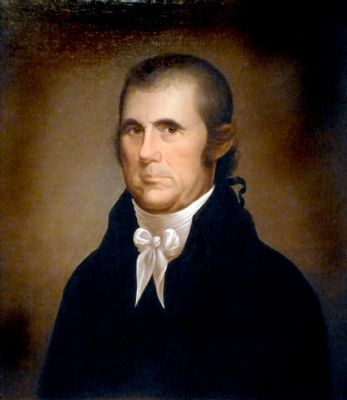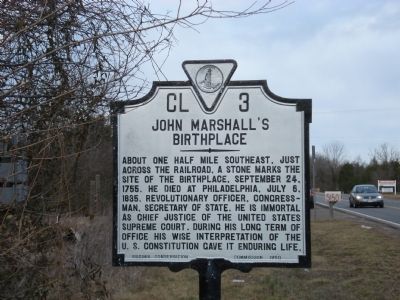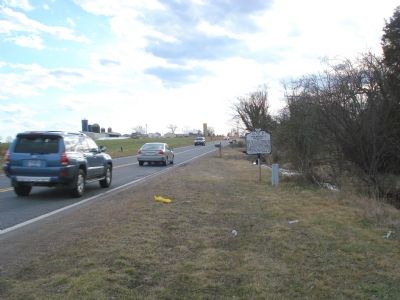Near Midland in Fauquier County, Virginia — The American South (Mid-Atlantic)
John Marshall’s Birthplace
Erected 1950 by Virginia Convservation Commission. (Marker Number CL-3.)
Topics and series. This historical marker is listed in this topic list: War, US Revolutionary. In addition, it is included in the Virginia Department of Historic Resources (DHR) series list. A significant historical date for this entry is July 6, 1861.
Location. 38° 36.378′ N, 77° 43.033′ W. Marker is near Midland, Virginia, in Fauquier County. Marker is on Catlett Road (Virginia Route 28) 0.1 miles south of Smith Midland Lane, on the right when traveling south. Touch for map. Marker is in this post office area: Midland VA 22728, United States of America. Touch for directions.
Other nearby markers. At least 8 other markers are within 6 miles of this marker, measured as the crow flies. John Marshall’s Birthplace Park (approx. 0.4 miles away); a different marker also named John Marshall’s Birthplace (approx. 0.4 miles away); German Town (approx. 1˝ miles away); Elk Run Village (approx. 4.4 miles away); Elk Run Anglican Church Site (approx. 4.4 miles away); Stuart and Mosby (approx. 4.7 miles away); Catlett’s Station (approx. 5.3 miles away); Mosby’s Raid at Catlett’s Station (approx. 5.4 miles away). Touch for a list and map of all markers in Midland.
Also see . . . From Revolution to Reconstruction, Biographies, John Marshall. (Submitted on July 19, 2007, by Roger Dean Meyer of Yankton, South Dakota.)

Photographed By Allen C. Browne, January 18, 2014
4. John Marshall
This 1809–10 portrait of John Marshall by Cephus Thompson hangs in the National Portrait Gallery in Washington DC.
“John Marshall, the fourth chief justice of the United States, established the concept of judicial review — in which the Supreme Court could pronounce a law of Congress as unconstitutional — and strengthened the idea of an independent federal judiciary. In cases brought to the Court between 1810 and 1824 — years in which the Marshall Court enjoyed great stability and harmony — Marshall used the Court's judicial review to nullify state laws violating constitutional restraints of state power. The effect of Marshall's long tenure as chief justice (1801-35) was to strengthen the Court, the Constitution, and the federal government. The Court became a preeminent interpreter of the Constitution, and the federal government's enumerated powers were given a broad interpretation and made superior to those of the states.
Cephas Thompson painted a portrait of Marshall from life in Richmond, as well as six replicas for admirers, two years after Marshall presided at the trial of Aaron Burr for treason.” — National Portrait Gallery
“John Marshall, the fourth chief justice of the United States, established the concept of judicial review — in which the Supreme Court could pronounce a law of Congress as unconstitutional — and strengthened the idea of an independent federal judiciary. In cases brought to the Court between 1810 and 1824 — years in which the Marshall Court enjoyed great stability and harmony — Marshall used the Court's judicial review to nullify state laws violating constitutional restraints of state power. The effect of Marshall's long tenure as chief justice (1801-35) was to strengthen the Court, the Constitution, and the federal government. The Court became a preeminent interpreter of the Constitution, and the federal government's enumerated powers were given a broad interpretation and made superior to those of the states.
Cephas Thompson painted a portrait of Marshall from life in Richmond, as well as six replicas for admirers, two years after Marshall presided at the trial of Aaron Burr for treason.” — National Portrait Gallery
Credits. This page was last revised on December 25, 2019. It was originally submitted on July 19, 2007, by Roger Dean Meyer of Yankton, South Dakota. This page has been viewed 1,618 times since then and 29 times this year. Photos: 1, 2. submitted on July 19, 2007, by Roger Dean Meyer of Yankton, South Dakota. 3. submitted on August 30, 2007, by Kevin W. of Stafford, Virginia. 4. submitted on July 16, 2015, by Allen C. Browne of Silver Spring, Maryland. • J. J. Prats was the editor who published this page.


